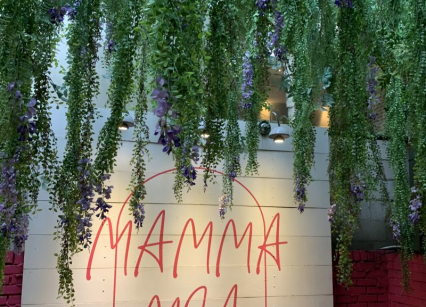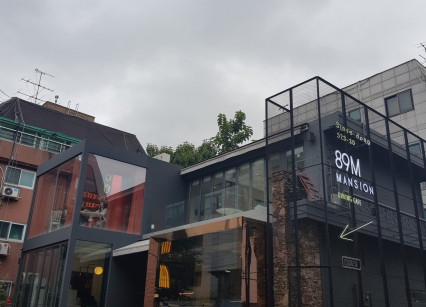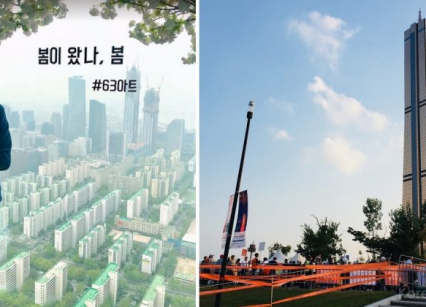Feel the need to escape the busy roads with buses passing along noisily, and the shopping streets with music blaring from every window? Although Korea is a very dynamic country, it is also easy to get your nature fix. When relying on public transport, and not with a budget to book a spa hotel, it only takes a short trip for a change of scenery, to recharge your batteries and to get in touch with Korea’s beautiful nature. I introduce to you, Gwangju’s very own, Gwangju Lake Waterside Eco Park.
How to get to Gwangju Lake Waterside Eco Park
A picturesque bus ride up Mudeungsan (무등산)mountain, (bus 187/2-1/ 2-2 which don’t run very regularly – so depart on time and make sure you get home!) get off at the Gwangju Waterside Eco Park bus stop. The bus ride is a short hour from the U-square bus terminal. Feeling you’re in the middle of nowhere, a beautiful cafe with terrace await you to freshen up before heading to the park.
The lake park welcomes you with flowers and a cute little bridge over a stream. You then decide to go left or right. Beautiful in all seasons, you can see the leaves changing color on every tree, flowers blooming, and you feel at peace in 1,2,3. Cross wooden bridges, find observation spots, and walk along the vast lake that seems to drop off the end of the Earth. Don’t forget to get a stamp from one of the observation decks. Birds will fly over the lake, making for picturesque landscape shots. The noises of bustling traffic long forgotten, you feel at one with nature here. Although there are no cafes inside the park, there are toilets along the paths, and straw-roofed shaded platforms. The park is well-kept, and paths are bicycle-friendly.

A bit of history, the Eco Park opened in March 2006. It is divided into themed districts, featuring a natural observation center, an eco-experience center, and more. In the flower district, you can spot up to 170,000 kinds of wild flowers including azaleas, forsythia, smile rosebay, roses, royal azaleas and hydrangeas. It hosts over 3,000 kinds of trees including snowbells, quince, Chinese parasol trees, Japanese maples, and Metasequoia trees. At the wetlands district, you may actually see how birds hatch and grow. An educational perk, many flower beds and trees are labeled, so you go home having learned a few names.
A tip: don’t stay too long after dark. The park remains eco-friendly, so no bright lights to guide the way.

What’s next?
Once you feel comfortable leaving this sanctuary and want to venture to other places in the neighborhood, such as the Hwanbyeokdang Pavilion, Yeonhwa Jeongsa Temple, or you can walk down the main road and cross the stream, to encounter the Siga Culture Historical Site, Sigyeongjeong Pavilion, and the Gasa Literary Museum. Also situated in a lush green garden with a pond containing Koi fish jumping up once in a while. The Gasa Literary Museum is designed in the same style as the Gwangju National Museum, and the Blue House, with a 1950’s Japanese architectural style. One can take absolutely stunning photos.
History fact:
The word Gasa comes from the Korean poems written during the Joseon era, when mostly Chinese literature was read. You can see 18 of them at the museum, which makes Damyang ‘the heart of Gasa poetry’. The nearby Soswaewon Garden is known to have inspired the Gasa poets.

For a mere 2,000 won entrance fee, you can view ancient literary works of the Chosun dynasty, old almanacs and manuscripts beautifully displayed. The museum is located in a large green zone that crosses over to Damyang, circumventing numerous sites including the Damyang Bamboo Garden (죽녹원), Metasequoia Lane, (a 2km lane lined with metasequoia trees that look best in fall) and Little Provence (a small ‘town’ with a Provencial design filled with bright little cafes, restaurants, and photo spots). Maps are available at the ticket booth of the Gasa Literary Museum.
Further down is the Soswaewon Garden, that organizes cultural activities for foreigners on Saturdays, and the Sigyeongjeong Pavilion (식영정) literally means a place where even the shadow of the moon can find a place to rest. As its name suggests, this pavilion is set in a lush and remote forested area..
You can take the bus back home in front of the Gasa Literary Museum. If you time it right, you can get off at the Mudeungsan Observatory (무등산 전망대). A stand-alone building holding a small make-shift café with a terrace overlooking the entire city along the shrubbery up the mountain road. One beverage per person must be consumed in order to go up to the terrace. Sunset red-filled clouds, the grey-green mountains as a backdrop, and the twinkling of lights in tall apartment buildings meet the eye.
Read More: A Day in Gwangju: Pretty Neighbourhood of Yangnim-Dong







